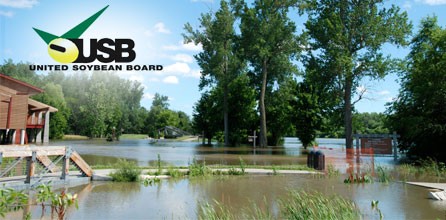
Biobased Soy Spray Foam Insulation Protects in Flood-Prone Areas
Mother Nature’s record 2008 floods wreaked havoc on an Eastern Iowa Nature Center. Today, the building is better insulated than ever thanks to spray foam insulation that uses naturally renewable soy and also meets Federal Emergency Management Administration (FEMA) requirements.
The Indian Creek Nature Center, a nonprofit organization on the Cedar River, is located on a former dairy farm. The Center has 200 acres of land with trails and various outdoor activities that attract about 45,000 people annually. The main building of the facility is an old dairy barn converted into offices and activity areas. It had been previously insulated with ordinary fiber glass material.
“The building was completely saturated with the flood and the (insulation) had to be removed,” says Rich Patterson, the Center’s executive director. We used Sage Companies to install the foam insulation and are very pleased. Not only does the closed-cell soy foam meet the FEMA/National Flood Insurance Program (NFIP) regulations, but we also found it to be a superior insulation in every way.
“The barn was built in 1932 of red tile brick that is sturdy and attractive but has many holes and cracks that allow cold air to infiltrate. The foam insulation sealed these very well,” Patterson says. “Nature Center staff was amazed to see how much foam oozed through the exterior of the brick, indicating where there were cracks and holes in the wall, often very small ones, but ones that let a lot of cold air in.”
Sage Companies LLC in Cedar Rapids applies BioBased Insulation® 1701 high-density closed cell, polyurethane spray foam insulation made with soy from Biobased Technologies. “In 2008 our area of Southeast Iowa, experienced not a 100-year flood, but rather a 500-year flood,” explains Sage’s Pat Shey. “Closed-cell foam insulation does not absorb as much water in flood situations and it dries out much more quickly than non-foam insulation materials, which usually need to be removed once they become wet and saturated with moisture.”
Sprayed polyurethane foam and closed-cell plastic foams are the only materials that FEMA classifies as acceptable flood damage-resistant insulation materials for floors, walls and ceilings in its building design criteria for special flood hazard areas (SFHAs). This requirement applies to new construction, repair of substantially damaged buildings, and substantial improvement of existing buildings in SFHAs. To protect buildings constructed in SFHAs, FEMA’s National Flood Insurance Program (NFIP) requires the use of building materials that are “resistant to flood damage.”
FEMA designates sprayed polyurethane foam and closed-cell plastic foams as a Class 5 flood damage-resistant building material. Class 5, which is FEMA’s highest rating, are materials considered highly resistant to floodwater damage, including damage caused by moving water, and can survive wetting and drying and may be successfully cleaned after a flood to render them free of most harmful pollutants.








